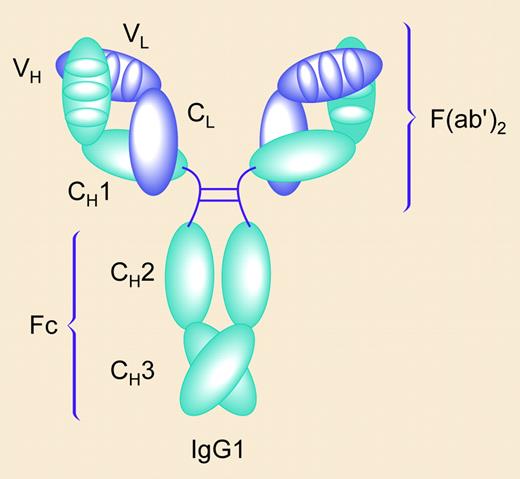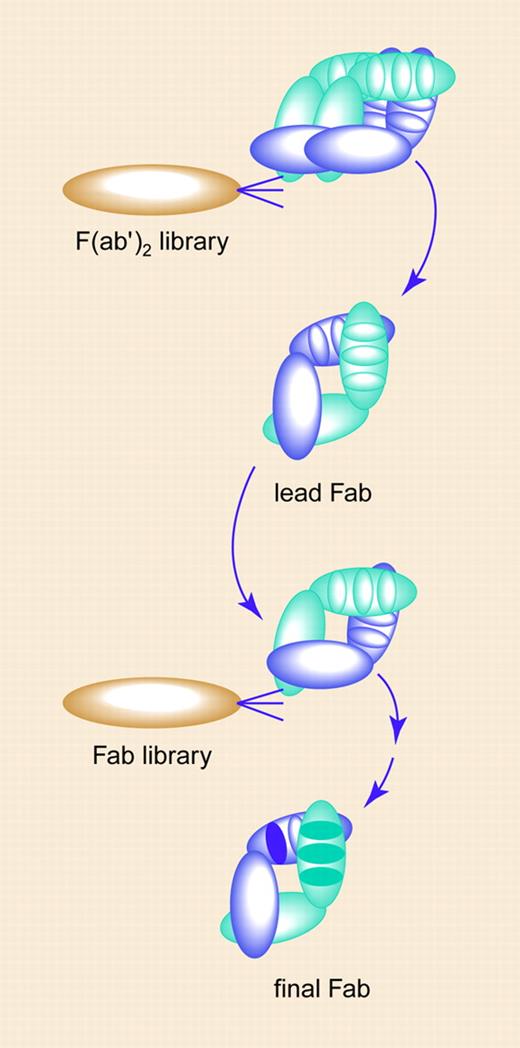Comment on Lee et al, page 3103
As if taken from a Michael Crichton novel, the evolution of synthetic antibodies that target B cells, the architects and manufacturers of natural antibodies, is described by Lee and colleagues.
At the center of this twist is BAFF, a soluble ligand that mediates B-cell survival and maturation through its receptor BR3. Antagonists of the BR3/BAFF interaction are of considerable interest for the therapy of B-cell malignancies and autoimmune diseases.1 In their quest for human monoclonal antibodies (mAbs) to BR3 that antagonize the BR3/BAFF interaction with high precision and, at the same time, cross-react with human and murine BR3, Lee and colleagues turn to synthetic human antibody libraries and phage display technology. Not only do they meet their challenge, but they analyze the outcome in meticulous structural detail, providing important insights to antibody/antigen interactions that delineate affinity, specificity, and species cross-reactivity at the molecular level.FIG1
The antibody molecule, here shown as IgG1, contains 2 identical light chains (purple) and 2 identical heavy chains (green). The light chain consists of 1 N-terminal variable domain (VL) followed by 1 constant domain (CL). The heavy chain consists of 1 N-terminal variable domain (VH) followed by 3 constant domains (CH1, CH2, and CH3). The antigen-binding site results from the convergence of 6 CDRs, 3 provided each by VL and VH. F(ab′)2 and Fc fragments of the antibody molecule are indicated. Illustration by Paulette Dennis.
The antibody molecule, here shown as IgG1, contains 2 identical light chains (purple) and 2 identical heavy chains (green). The light chain consists of 1 N-terminal variable domain (VL) followed by 1 constant domain (CL). The heavy chain consists of 1 N-terminal variable domain (VH) followed by 3 constant domains (CH1, CH2, and CH3). The antigen-binding site results from the convergence of 6 CDRs, 3 provided each by VL and VH. F(ab′)2 and Fc fragments of the antibody molecule are indicated. Illustration by Paulette Dennis.
Currently, 17 of 18 mAbs approved for therapeutic applications by the Food and Drug Administration (FDA) are derived from murine mAbs generated by hybridoma technology.2 Murine mAbs are highly immunogenic in humans, severely limiting their therapeutic applications and making antibody humanization or at least chimerization mandatory if repeated administration is required. In addition, murine mAbs to human antigens often do not cross-react with the murine antigen, which weakens the reliability of activity and toxicity profiles of mAbs in murine models of human disease. Based on these considerations, the ideal therapeutic mAb is human and cross-reacts with human and murine antigens while maintaining high specificity and strong affinity.
With the conception of phage display technology, the generation of human mAbs with selectable properties, including affinity, specificity, and species cross-reactivity, has become reality. The hallmark of phage display and combinatorial antibody technology is the physical connection of antibody phenotype (protein) and genotype (cDNA), effectively allowing selection rather than screening of mAbs from vast libraries. In addition, and in contrast to hybridoma technology, phage display permits the generation of mAbs from virtually any species whose immunoglobulin genes are known. In particular, large naive and synthetic human antibody libraries have become accessible through phage display technology, yielding the first FDA-approved library-derived human mAb, adalimumab, and dozens more human mAbs at various stages in preclinical and clinical development.2 FIG2
Synthetic human antibody libraries used by Lee and colleagues are based on phage-displayed bivalent F(ab′)2 or monovalent Fab with randomized CDRs. Starting out from bivalent F(ab′)2 libraries that use avidity to make up for weak affinities, a Fab lead with micromolar affinity to the murine antigen and even weaker cross-reactivity with the human antigen was selected. Iterative optimization strategies that involved both simultaneous and sequential selections of randomized CDRs resulted in a final Fab that bound both murine and human antigen with subnanomolar affinity. Compared with the lead Fab, the final Fab had acquired 13 mutations spread over 4 CDRs (bold). Illustration by Paulette Dennis.
Synthetic human antibody libraries used by Lee and colleagues are based on phage-displayed bivalent F(ab′)2 or monovalent Fab with randomized CDRs. Starting out from bivalent F(ab′)2 libraries that use avidity to make up for weak affinities, a Fab lead with micromolar affinity to the murine antigen and even weaker cross-reactivity with the human antigen was selected. Iterative optimization strategies that involved both simultaneous and sequential selections of randomized CDRs resulted in a final Fab that bound both murine and human antigen with subnanomolar affinity. Compared with the lead Fab, the final Fab had acquired 13 mutations spread over 4 CDRs (bold). Illustration by Paulette Dennis.
Synthetic human antibody libraries3 are based on randomized complementarity determining regions (CDRs) of the variable domains of light and heavy chains (see the figure on the left on page 2889). Analogous to chemical libraries, synthetic human antibody libraries allow iterative optimization by simultaneous and sequential selections of randomized CDRs, ultimately providing selectable solutions for many challenging antigens (see the figure on the right on page 2889).
Facing rapid progress of human mAb engineering and evolution through phage display technology, hybridoma technology has maintained a competitive position through further advancements, in particular the development of transgenic mice expressing human antibodies.2 However, the work by Lee and colleagues reiterates the advantage of phage display technology when it comes down to generating human mAbs with highly defined properties. ▪



This feature is available to Subscribers Only
Sign In or Create an Account Close Modal